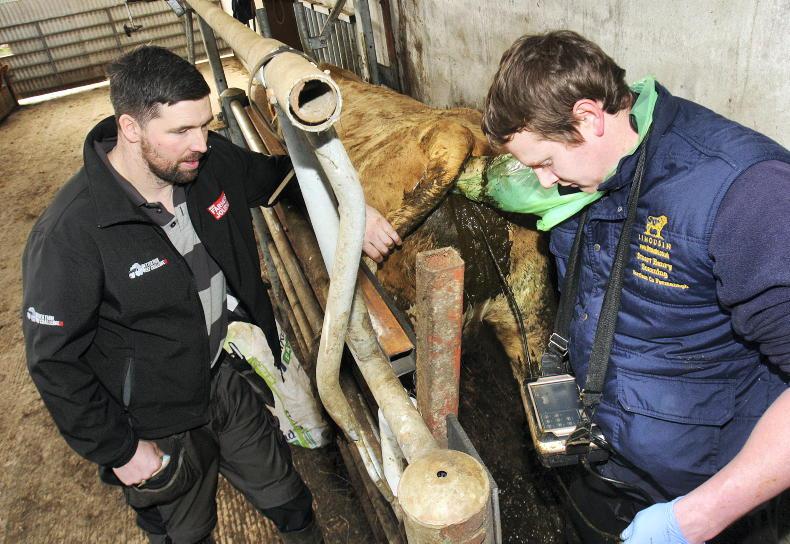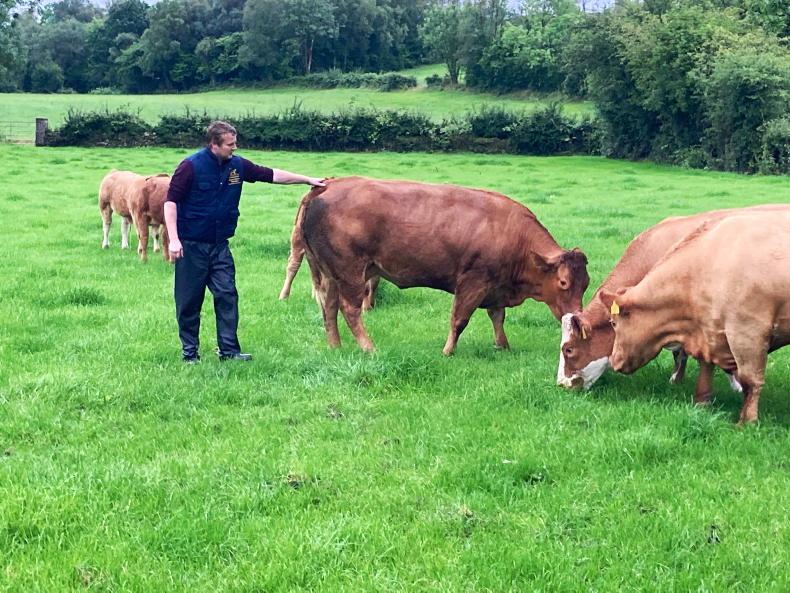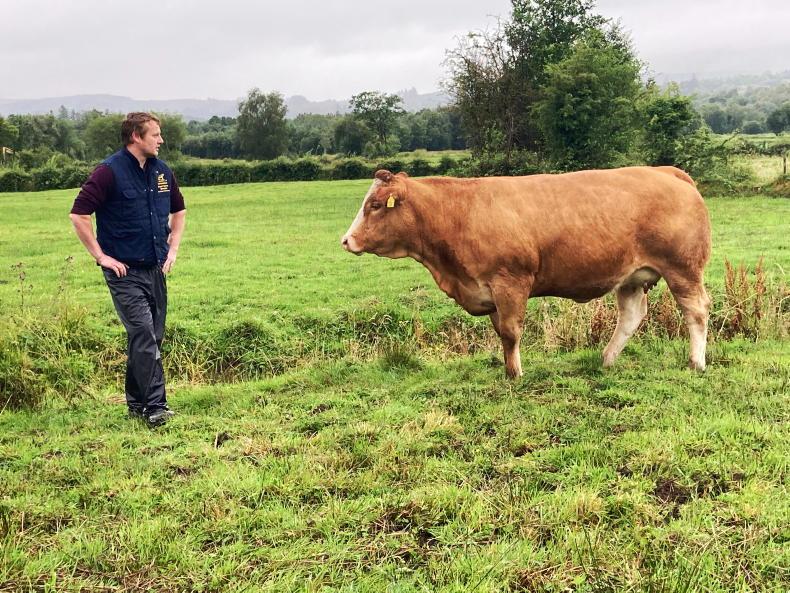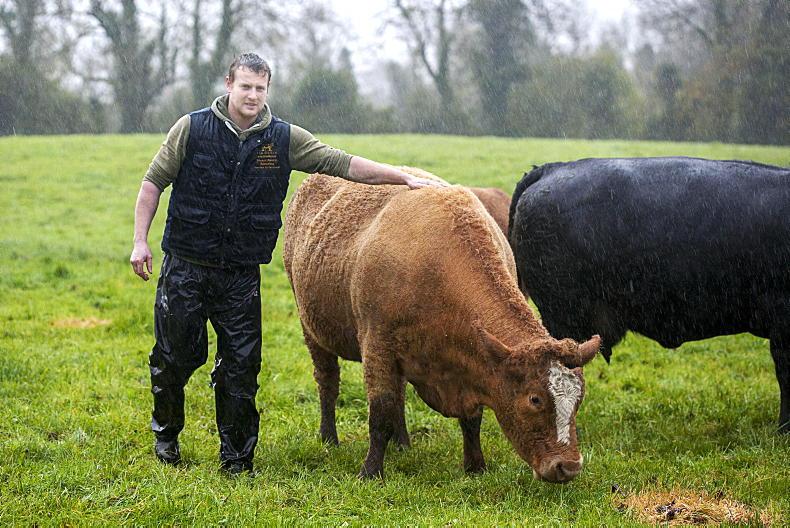Stuart Henry, like most suckler farmers in the border region, juggles the farm with a few jobs. He works full-time in a local co-op and also provides an AI and scanning service to farmers in the Fermanagh area.
Stuart has a strong interest in breeding top-quality cattle and doesn’t see any point in selling an average weanling.
“Over the last few years I’ve improved the overall herd quality and the difference can be seen as soon as you walk into the yard and more importantly the sales ring,” he says.

Stuart Henry tends his sucklers on his Co Fermanagh Farm. \ Brian Farrell.
Suckler system
Stuart runs a herd of 25 suckler cows. He is currently trying to breed his own replacements.
His herd is split into three groups, calving at different times. One group calves in August and September, the next group in November and the next group in the spring.
Having the herd split allows Stuart calve these smaller groups without being under pressure for space in calving pens.
“Calving smaller batches allows me to continue working as well and I can keep an eye on the cameras if something is near calving, because it is less intense.
“It also works well on heavy soils. The farm can be split in sections, with the oldest calves being left on the more difficult areas of the farm early in the grazing year as they would be moved on to creep feeding at that stage and are not as reliant on the cow’s milk.”
Heavier soils mean a longer winter and Stuart, like most farmers in the west and northwest, struggles with this problem.

Stuart Henry scanning a batch of 48 suckler cows on Barry Carty’s farm outside Garrison.
Stocking rate
When it comes to managing difficult ground, he believes “less is more” in terms of his stocking rate because he feels if he was over-stocked it would turn what is already a long winter into an even longer winter, where he would then struggle with fodder supplies and space at calving times.
Stuart runs a 100% AI system, using a vasectomised bull to pick up cows in heat.
He feels this works well as he can clearly identify which cows are in heat when checking them twice daily.
Being a trained AI technician means he doesn’t have to wait on an AI man or isn’t tied to a certain selection of bulls from one AI station as he can pick and choose what he uses.
Stuart’s full-time job is in Killasnett Co-op in Manorhamilton, Co Leitrim, where he has worked in the yard as a forklift operator for the last nine years.
This job works well for Stuart as it is just 15 minutes from his farm and the employers at the co-op are very understanding of all the commitments that farmers have.
As well as working full-time in the co-op, Stuart also runs his own scanning and AI service. He covers Co Fermanagh and some of north Leitrim carrying out AI and scanning for local farmers.
Stuart has been running this service in his local area over the last 10 years.
“It gets busier every year, with more and more people scanning every year.”
It costs too much to have a cow repeating or lying idle for a time throughout the year so more and more farmers are scanning to see where problems lie and maybe implementing a stricter culling process on there farms as a result.
Juggling these jobs with the farm can be quite difficult but Stuart is lucky in the sense he still has his father around to give him a hand during busy periods and to aid in jobs that need more people than one person.

Stuart out checking some of his spring-calving herd.
Managing the AI calls as well as scanning can be difficult but generally AI works with the AM-PM rule so whoever calls in the evening is on the list for the next morning and whoever rings in the morning is on the list for the evening, so scanning can be planned alongside AI calls.
Due to the nature of the area in which Stuart is working, scanning can be generally carried out in small numbers at a time: “I am always kept going with my day starting at 6am most days, although I wouldn’t be doing it if I didn’t love it.
“I often move fences a week in advance of cattle needing the grass just to be ahead of myself; you see a lot of that around here. Part-time farmers need to be very organised to make things work.”
Stuart can see his farming system staying with similar numbers of cows in the future. He hopes to improve his herd quality even more by introducing new genetics through AI.
Stuart has started some of this by using sexed semen to breed replacement heifers off his best cows. He generally uses Simmental and Limousin straws in his sexed semen selections whereas the rest of his herd usually get Charolais straws.
Stuart has also put a great emphasis on grass growth on his farm in recent years by implementing a liming plan to improve the pH of the soils as well as planning to reseed older pastures and re-introduce ryegrass into some of the fields.
“Ever since we started the liming plan the grass growth has been immense on the farm compared to beforehand.”

Stuart checking on his in-calf replacement heifers which are due to calve in the coming weeks.
Farm facts
Location: Garrisson, Co Fermanagh
Size: 120 acres of heavy soils
System: Suckler to weanling
Cow numbers: 25
Cow Type: Limousin x Simmental
Sires: Fiston, Firoda Jason, Clogher Finn, Coose Jericho
Stuart Henry, like most suckler farmers in the border region, juggles the farm with a few jobs. He works full-time in a local co-op and also provides an AI and scanning service to farmers in the Fermanagh area.
Stuart has a strong interest in breeding top-quality cattle and doesn’t see any point in selling an average weanling.
“Over the last few years I’ve improved the overall herd quality and the difference can be seen as soon as you walk into the yard and more importantly the sales ring,” he says.

Stuart Henry tends his sucklers on his Co Fermanagh Farm. \ Brian Farrell.
Suckler system
Stuart runs a herd of 25 suckler cows. He is currently trying to breed his own replacements.
His herd is split into three groups, calving at different times. One group calves in August and September, the next group in November and the next group in the spring.
Having the herd split allows Stuart calve these smaller groups without being under pressure for space in calving pens.
“Calving smaller batches allows me to continue working as well and I can keep an eye on the cameras if something is near calving, because it is less intense.
“It also works well on heavy soils. The farm can be split in sections, with the oldest calves being left on the more difficult areas of the farm early in the grazing year as they would be moved on to creep feeding at that stage and are not as reliant on the cow’s milk.”
Heavier soils mean a longer winter and Stuart, like most farmers in the west and northwest, struggles with this problem.

Stuart Henry scanning a batch of 48 suckler cows on Barry Carty’s farm outside Garrison.
Stocking rate
When it comes to managing difficult ground, he believes “less is more” in terms of his stocking rate because he feels if he was over-stocked it would turn what is already a long winter into an even longer winter, where he would then struggle with fodder supplies and space at calving times.
Stuart runs a 100% AI system, using a vasectomised bull to pick up cows in heat.
He feels this works well as he can clearly identify which cows are in heat when checking them twice daily.
Being a trained AI technician means he doesn’t have to wait on an AI man or isn’t tied to a certain selection of bulls from one AI station as he can pick and choose what he uses.
Stuart’s full-time job is in Killasnett Co-op in Manorhamilton, Co Leitrim, where he has worked in the yard as a forklift operator for the last nine years.
This job works well for Stuart as it is just 15 minutes from his farm and the employers at the co-op are very understanding of all the commitments that farmers have.
As well as working full-time in the co-op, Stuart also runs his own scanning and AI service. He covers Co Fermanagh and some of north Leitrim carrying out AI and scanning for local farmers.
Stuart has been running this service in his local area over the last 10 years.
“It gets busier every year, with more and more people scanning every year.”
It costs too much to have a cow repeating or lying idle for a time throughout the year so more and more farmers are scanning to see where problems lie and maybe implementing a stricter culling process on there farms as a result.
Juggling these jobs with the farm can be quite difficult but Stuart is lucky in the sense he still has his father around to give him a hand during busy periods and to aid in jobs that need more people than one person.

Stuart out checking some of his spring-calving herd.
Managing the AI calls as well as scanning can be difficult but generally AI works with the AM-PM rule so whoever calls in the evening is on the list for the next morning and whoever rings in the morning is on the list for the evening, so scanning can be planned alongside AI calls.
Due to the nature of the area in which Stuart is working, scanning can be generally carried out in small numbers at a time: “I am always kept going with my day starting at 6am most days, although I wouldn’t be doing it if I didn’t love it.
“I often move fences a week in advance of cattle needing the grass just to be ahead of myself; you see a lot of that around here. Part-time farmers need to be very organised to make things work.”
Stuart can see his farming system staying with similar numbers of cows in the future. He hopes to improve his herd quality even more by introducing new genetics through AI.
Stuart has started some of this by using sexed semen to breed replacement heifers off his best cows. He generally uses Simmental and Limousin straws in his sexed semen selections whereas the rest of his herd usually get Charolais straws.
Stuart has also put a great emphasis on grass growth on his farm in recent years by implementing a liming plan to improve the pH of the soils as well as planning to reseed older pastures and re-introduce ryegrass into some of the fields.
“Ever since we started the liming plan the grass growth has been immense on the farm compared to beforehand.”

Stuart checking on his in-calf replacement heifers which are due to calve in the coming weeks.
Farm facts
Location: Garrisson, Co Fermanagh
Size: 120 acres of heavy soils
System: Suckler to weanling
Cow numbers: 25
Cow Type: Limousin x Simmental
Sires: Fiston, Firoda Jason, Clogher Finn, Coose Jericho
















SHARING OPTIONS